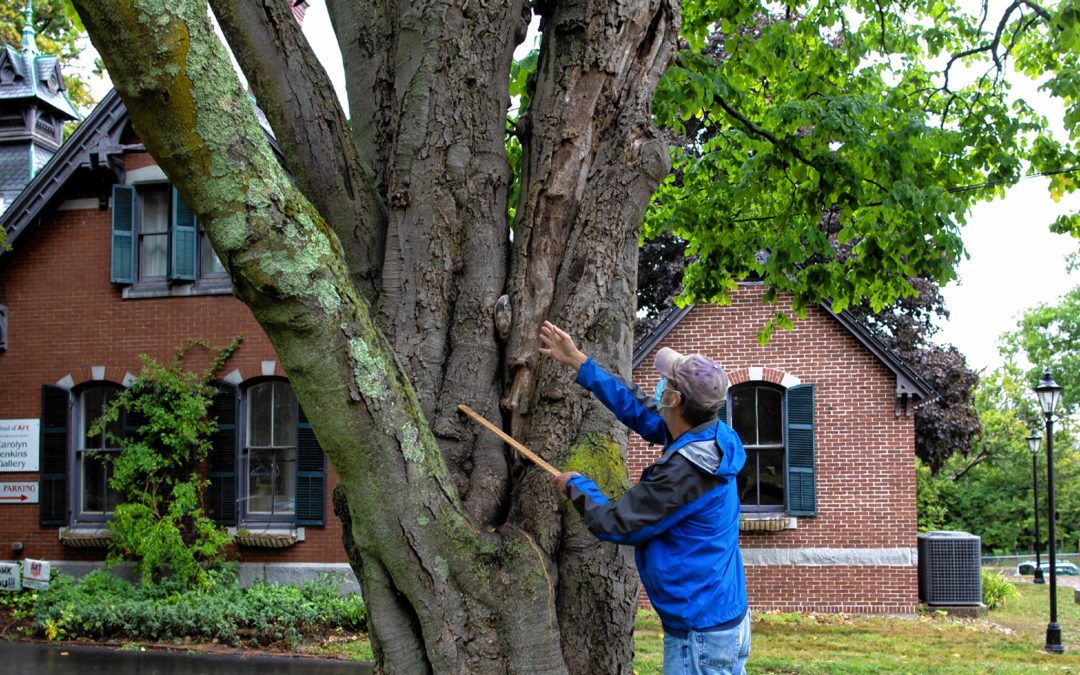Some trees in New Hampshire that have been certified as the biggest in their species are going to lose their title – not because they’re shrinking, but because a change has been made in how to measure trees with multiple trunks.
Already dethroned is an Eastern white pine in the Keene area that for many years was considered the biggest in the nation by the Big Tree Program but now is only the biggest in Cheshire County.
It won’t be the last. Sam Stoddard, who helps oversee the program in the state, estimates that there are 100 to 150 “multi-trunkers” on the state’s list of Big Trees. “We have to re-measure them, and for many their standings will change,” he said.
Tim Fleury, the county forester for Merrimack County, says this be unsettling for some but it’s a good sign for the 75-year-old Big Tree Program. “I think it shows a real interest in the program, that it’s becoming more precise,” he said.
The change to Big Tree Program processes is designed to give a more consistent answer to what sounds like a simple question: How do you measure the size of a tree?
Making that determination is complicated enough that the nonprofit American Forests, which operates the Big Tree Program, has put out an 86-page guidebook for workers and volunteers. It includes algebraic formulas, discussions about slope estimation and pith analysis, directions for spreadsheet calculations, plus instructions for using instruments such as densitometers, red-beam lasers and advanced hypsometers “with capability to do sine-based height measurements.”
Finally, it notes, things may change again: “All these guidelines are works in progress and will undergo revision as new methods and equipment become available.”
Three measurements
The Big Tree program ranks trees with a score that combines three measurements: estimated height at the tallest point; estimated spread of branches at the widest point, known as crown spread; and circumference of the trunk at breast height, or 4 1/2 feet above the ground.
The first two seem the hardest to determine since they require making measurements through instruments from a distance, usually 100 feet away. When a candidate tree is deep in the forest or on sloping or broken ground, getting a good view to make those measurements can be difficult.
Measuring circumference at breast height is more straightforward: Just walk up and put a tape measure around it.
But this is where complication arises because many trees don’t grow nice, straight trunks. They split, they twist, they bend and merge, raising questions about what exactly to measure.
“The puzzle of how to make a level playing field between single-trunk and multi-trunk trees has been the subject of discussion and debate for 10 years,” said Stoddard, of Rochester.
Stoddard, formerly the county forester for Coos County, is very familiar with this topic. He is one of some three dozen members of the National Cadre of Tree Measurers, the group that oversees the Big Tree Program.
The new solution involves visually determining the pith or exact center of a trunk or trunks and their status at ground level and breast height.
“In the old days you’d wrap a tape measure around these multiple trunks and come up with a huge number,” said Stoddard.
Now, however, a more nuanced approach is called for and in some cases – like that pine tree near Keene – it means ignoring a portion of what might seem to be part of the tree.
To an extent this doesn’t really matter because there’s no monetary or other reward associated with a Big Tree title. But that doesn’t mean changes won’t rattle a few people if the tree involved is on their property.
“It’s a matter of pride,” Fleury said of the title. “If a tree is not the champion tree any more they might be disappointed.”
But in long run, he added, the important thing is still there: “There’s still the beauty of the tree. It hasn’t changed.”
For more on the New Hampshire Big Tree program, see the website: extension.unh.edu/programs/nh-big-trees


 Return to the Concord Monitor
Return to the Concord Monitor